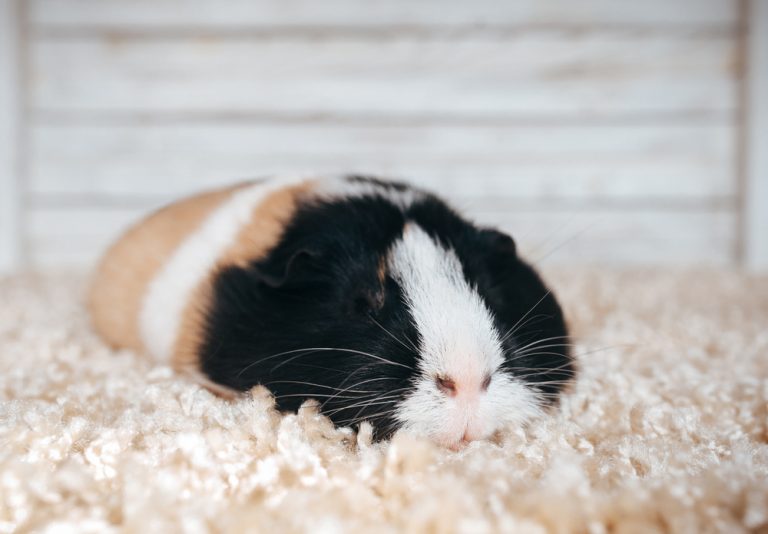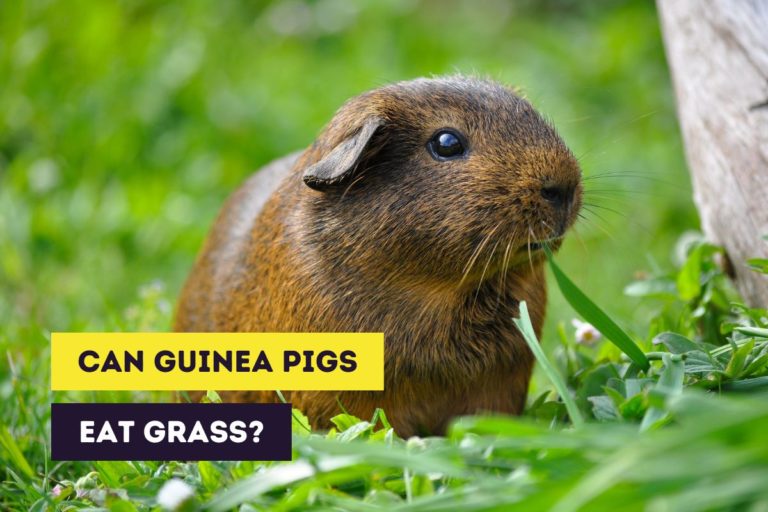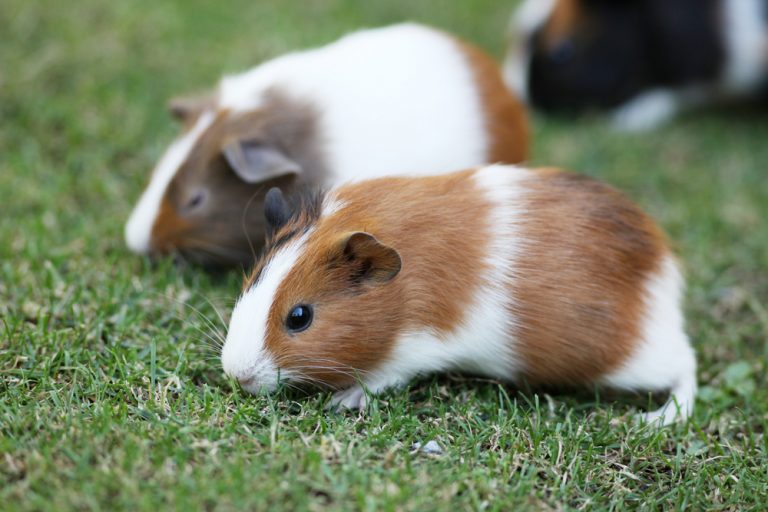Can Guinea Pigs Eat Watermelon? (Fresh, Dried and Seeds)
Guinea pigs are known to benefit from eating fresh grass and vegetables. But they are also allowed to eat fruit now and then. However, not all fruit is safe for guinea pigs and you can only give some fruit on rare occasions. For example, watermelons are a delicious fruit; most of us like to eat them on warm summer days. But can guinea pigs eat watermelon?
Guinea pigs can only eat watermelon as a treat once a week. You can give your guinea pigs one tablespoon (15 g) of fresh watermelon or one teaspoon (5 g) of dried watermelon. Guinea pigs can eat the flesh and the rind of a watermelon, but you shouldn’t feed the seeds.
A healthy diet for guinea pigs should consist of grass (hay), fresh vegetables, and pellets. Fruit should only be a small part of their diet because they lack the necessary fibers and contain a lot of water and sugar. Watermelon is no exception but can be given to your guinea pigs when given occasionally and in the proper proportions.
This site contains affiliate links to products we recommend and use ourselves. We may receive a commission for purchases that you make through these links. If you’re interested in learning more about our affiliate links, please visit our (affiliate) disclaimer.
Nutritional Value of Watermelon
The following nutritional data (for 100 g) comes from FoodData Central:
Benefits of Eating Watermelon
High percentage of water
Guinea pigs usually drink about 100 ml/kg of water daily, depending on the temperature and humidity, activity level, and general health.[1]Clemons, D. J., & Seeman, J. L. (2011). The Laboratory Guinea Pig, Second Edition. Taylor & Francis This is more than the water intake of some other pocket pets, such as gerbils and degus. When guinea pigs don’t drink enough, they can get health problems. Typical signs of dehydration are dry stool and dark urine.[2]https://www.msdvetmanual.com/all-other-pets/guinea-pigs/disorders-and-diseases-of-guinea-pigs
A piece of watermelon contains around 92 percent of water. So when your guinea pig isn’t drinking enough or seems dehydrated, you can feed a slice of watermelon to increase water consumption. Adding a bite-sized piece of watermelon on warm days can be especially beneficial.
Vitamins and minerals
Watermelons are rich in vitamins and minerals. They are in particular rich in vitamin A, B6, and C.
Guinea pigs need between 10 and 50 mg of vitamin C daily.[3]https://vcahospitals.com/know-your-pet/guinea-pigs-feeding However, unlike most animals, guinea pigs can’t produce this vitamin. This is why they need to ingest vitamin C from their diet.[4]Clemons, D. J., & Seeman, J. L. (2011). The Laboratory Guinea Pig, Second Edition. Taylor & Francis
Guinea pigs with a vitamin C deficiency (scurvy) can become weak and lethargic. They may also lose their appetite, lose weight and get diarrhea.[5]https://www.msdvetmanual.com/all-other-pets/guinea-pigs/disorders-and-diseases-of-guinea-pigs
Watermelon contains 8.1 mg of vitamin C per 100 grams. Therefore, this fruit can help reach the required daily dose, in addition to other sources of vitamin C.
Precautions
Bad Ca:P ratio
According to scientific literature, this ratio should be around [2]:[1] for guinea pigs. Watermelon contains 7 mg calcium and 11 mg phosphorus per 100 grams. So, the calcium-to-phosphorus ratio of watermelon is [1]:[1.6].
Such a bad ratio between calcium and phosphorus can lead to soft tissue calcification.[6]https://www.ncbi.nlm.nih.gov/books/NBK231932/ Giving too much watermelon and not providing a balanced diet can lead to health issues and a decreased lifespan.
You can easily prevent this by providing the right proportions of (grass) hay, fresh vegetables, and pellets. Watermelons should only be given occasionally and in small bite-sized pieces. When you only give tiny amounts of watermelon, the Ca:P ratio of this fruit will have a neglectable influence.
High percentage of sugar
Most fruit contains a lot of (natural) sugars. For example, watermelons contain 6.2 g per 100 grams. However, too much sugar can cause health issues in guinea pigs. A high sugar intake can, for example, increase the number of harmful bacteria in the digestive system of your guinea pig.[7]https://www.petmd.com/exotic/what-can-guinea-pigs-eat
If you only give a small piece of watermelon, you won’t need to be scared. However, ensure that you don’t feed your guinea pigs other sugary foods (commercial treats or other fruit) when you also provide watermelons.
Dried or dehydrated watermelons contain much more sugar than fresh watermelons (60% or more). You should be aware of when you feed dried dehydrated watermelons. Limit the portion to one teaspoon once a week
Feeding Watermelons to Guinea Pigs
What kind of watermelons can be eaten by guinea pigs?
Watermelons are edible fruit and you can find watermelons almost anywhere in the world. They can be eaten in different ways:
- fresh
- dried or dehydrated
Below, you’ll find the most common ways to feed watermelon to guinea pigs. In short, guinea pigs can be fed:
- fresh seedless watermelons
- dried or dehydrated seedless watermelons
Certain treats you can buy online or in pet stores contain a watermelon flavor (but no real watermelons).
Fresh watermelons
Fresh watermelons are the most common way to give watermelon to guinea pigs. It’s recommended to give seedless watermelons. You will have to be careful to give the watermelon pieces in a food bowl (and why not this cute food bowl) or on a platform where your guinea pigs can eat them. Always check if there are leftover pieces and take them away when they’re not eaten after a few hours.

Dried or dehydrated watermelons
Dried or dehydrated watermelon goes through a process where most water is removed from the watermelon. The result is a smaller piece of watermelon that is deep red and looks wrinkled. Dried watermelons are sometimes called watermelon chips (but are not baked or fried like other chips).
Dried or dehydrated watermelons can be compared to fresh watermelons when it comes to nutrition but are easier to chew for guinea pigs and don’t go bad as fast as fresh watermelons. As they contain very little water, dried watermelons are less likely to cause diarrhea but contain more sugar.
If you want to dehydrate watermelons you can use a food dehydrator.
Commercial watermelon-flavored treats
Some treats, like the Vitakraft Drops, contain watermelon flavor. Most of them are high in sugar and fat content but some can be given for their purpose, a treat to be given on occasions. Fresh fruit or vegetables are a much better treat.
How many times to feed watermelons?
Fruit should only be given as a treat to guinea pigs once a week. They should never be given daily. A healthy guinea pig diet should consist of hay, fresh vegetables, and pellets. Fruit isn’t necessary for guinea pigs but can add a slight variation and taste to the diet.
How many watermelons can guinea pigs eat?
Guinea pigs can eat one tablespoon (15 g) of fresh watermelon a week. Always feed watermelon in tiny bite-sized pieces to make them easier to eat and digest. Dried watermelon should be limited to a teaspoon (5 g) a week because of the high percentage of sugar.
Want to Learn More?
If you’re interested in learning more about guinea pigs as pets, please read the following articles:
If you’re interested in getting guinea pigs as pets you should also definitely read our beginner’s guide to keeping guinea pigs as pets and our guinea pig care guide.
References
| ↑1, ↑4 | Clemons, D. J., & Seeman, J. L. (2011). The Laboratory Guinea Pig, Second Edition. Taylor & Francis |
|---|---|
| ↑2, ↑5 | https://www.msdvetmanual.com/all-other-pets/guinea-pigs/disorders-and-diseases-of-guinea-pigs |
| ↑3 | https://vcahospitals.com/know-your-pet/guinea-pigs-feeding |
| ↑6 | https://www.ncbi.nlm.nih.gov/books/NBK231932/ |
| ↑7 | https://www.petmd.com/exotic/what-can-guinea-pigs-eat |




